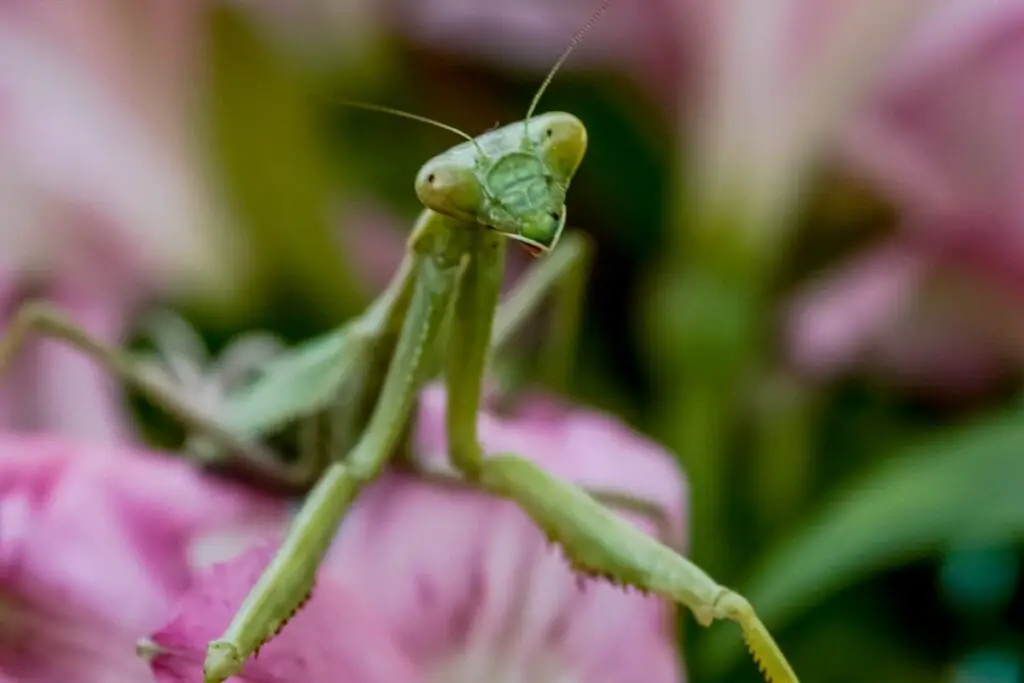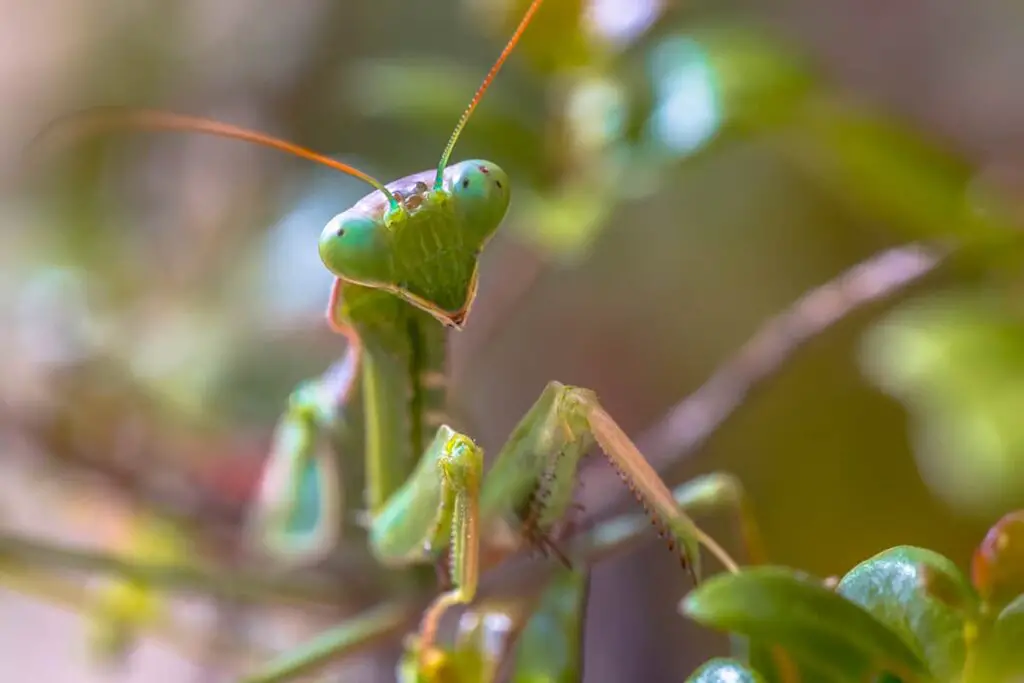Understanding the dietary needs of mantises is essential for their healthy growth and development. Just like us, these intriguing insects require specific nutrients during different stages of their life. As natural predators, they play a vital role in the ecosystem by managing pest populations, which makes their nutritional health important not only for them but also for our gardens.
Mantises are not picky eaters. Throughout their life cycle, from the nimble nymph to the formidable adult, mantises will prey on a wide array of insects. They primarily consume live prey, which provides them with the necessary proteins and other nutrients needed to grow strong and healthy. It’s quite fascinating how their diet changes as they grow; smaller nymphs might feast on tiny insects while adults can handle larger fare.
Understanding Mantises
Before delving into the fascinating world of mantises, it’s important for you to understand their unique biology and behavioral patterns. These insights will shed light on their predatory nature and how it contributes to their survival and growth.
Biology of Mantises
Mantises are adept predators with striking features that set them apart in the insect world. They possess triangular heads poised on a long neck, or an elongated thorax, giving them a distinct appearance. Additionally, their flexible necks allow them to rotate their heads 180 degrees to survey their environment. You may find it especially interesting that mantises have two large compound eyes and three simple eyes; this combination enhances their ability to detect movement and judge distance, crucial for capturing prey.
Their front legs are equipped with spikes and are exceptionally strong, enabling them to grip and hold onto their prey with ease. The sexual dimorphism in mantises is also quite pronounced, with females often larger and sometimes known to exhibit cannibalistic behavior after mating.
Behavioral Patterns
Mantises have evolved to become masters of camouflage and patience. Their ability to blend into the surroundings is not just for defense; it’s a strategic advantage for ambushing prey. Notably, their hunting strategy involves remaining motionless, waiting silently for an unsuspecting victim before striking with lightning-fast reflexes.
Your understanding of their diet is pivotal, as mantises primarily consume a variety of insects, and larger mantises may even prey on small vertebrates. They play a significant role in controlling pest populations, which can be beneficial to your garden or crops.
Mantises are solitary creatures, and their interactions are mostly limited to mating or territorial disputes. As you watch these fascinating insects, you’ll notice they rely heavily on their vision; their movements are calculated and deliberate, allowing them to navigate their environment with precision.
Components of Proper Growth
Proper growth in mantises involves a combination of nutritional intake and environmental factors that contribute to their well-being and development. Ensuring these elements are optimized is crucial for the health of your mantis.
Nutritional Requirements
To support their growth, mantises need a diverse diet that provides enough protein, carbohydrates, fats, and vitamins. Young mantises, or nymphs, require frequent meals of small insects like fruit flies, while larger adults benefit from more substantial prey such as grasshoppers and even small vertebrates. Your mantis’s diet should be high in protein to support muscle development and exoskeleton formation. Proper feeding frequency is essential, as over- or underfeeding can lead to health issues.
- Proteins: Essential for muscle and exoskeleton development.
- Carbohydrates: Provide energy for daily activities.
- Fats: Important for energy stores and overall health.
- Vitamins: Required for various bodily functions.
Environmental Factors
Environmental factors such as temperature, humidity, and habitat structure play pivotal roles in the proper growth of mantises. Ensure their enclosure mimics their natural habitat with adequate space for hunting and climbing. A temperature gradient within the enclosure allows your mantis to regulate body temperature appropriately. Adequate humidity is also vital to prevent dehydration and support successful molting, a critical growth process for mantises.
- Temperature: Maintain a gradient suitable for your mantis species.
- Humidity: Adjust levels to prevent dehydration and aid molting.
- Habitat Structure: Include vegetation and branches for natural climbing and hunting behavior.
Feeding Habits
Understanding the feeding habits of mantises is essential for ensuring their proper growth. You’ll learn how they choose their prey and how often they need to feed.
Prey Selection
When selecting prey, mantises are skilled predators that rely on live insects to thrive. Your praying mantis is likely to target a wide array of insects, favoring those that are adequate to their size. They’re proficient in catching medium-sized flies, grasshoppers, and an assortment of other insects. Baby praying mantises need frequent feeding and typically consume smaller prey due to their diminutive stature.
Feeding Frequency
The feeding frequency for your mantis will depend greatly on its life stage. Juvenile mantises are voracious eaters and may need to eat daily to support their rapid growth. As they mature, the frequency may decrease, but it remains important to offer food regularly to maintain their health. Adult mantises generally consume prey every 2-3 days, ensuring they receive the nutrients needed for optimal health and energy.
Frequently Asked Questions
In caring for your praying mantis, it’s essential to understand their dietary needs and feeding patterns for optimal health. The following FAQs address common concerns about feeding praying mantises.
What types of food are suitable for a praying mantis’s diet?
Praying mantises thrive on a diet of live insects such as flies, moths, and crickets. The nutritional value of these prey is crucial for their growth, and larger adults may occasionally eat small vertebrates.
How often should you feed a baby praying mantis?
You should feed your baby praying mantis every 1-3 days. The frequency depends on its size and age, but consistent feeding is key, especially as they are very hungry in the early stages of development.
Is it safe for a praying mantis to eat prey larger than itself?
It’s generally safe for praying mantises to attack and consume prey larger than themselves. They are adept predators and can handle sizeable prey, but it’s more common for them to target animals that are equal to or smaller than their own size.
Can a praying mantis be overfed, and if so, how can you tell?
Yes, a praying mantis can be overfed. Signs of overfeeding include rejection of food and a bloated abdomen. To avoid this, offer food in moderation and observe your mantis’s response to feeding.
What are some common feeding habits of a green praying mantis?
A green praying mantis typically waits in stealth among plants for prey to approach. They then strike quickly to capture their meal. They’re most active in hunting during the morning and evening.
At what point will a praying mantis stop feeding, signifying it is full?
A praying mantis will stop feeding when it turns away from offered food or loses interest in hunting. This behavior indicates that it has reached its feeding limit and is temporarily full.
Driven by a passion for those tiny creatures that rule our world, we at Bug Domain strive to be your go-to resource for information on insects.



